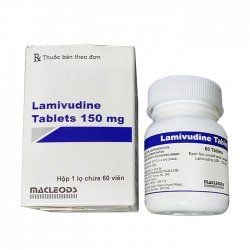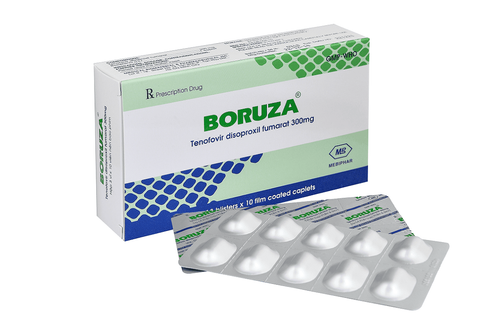This is an automatically translated article.
Zidorapine is a combination antiviral drug of 3 components Zidovudine Lamivudine and Nevirapine Anhydrous, indicated in the treatment of HIV.
1. What is Zidorapine?
Zidorapin contains active ingredients: Zidovudine 300 mg, Lamivudine 150 mg and Nevirapine Anhydrous 200 mg, which are antiviral drugs. Zidorapine is indicated for the treatment of HIV infections in adults and children from 12 years of age. Patients with AIDS or other advanced HIV infections are also prescribed Zidorapine.
Zidorapin can be used alone, or in combination with other HIV medicines to help control HIV infection.
Zidorapin helps reduce the viral load (HIV) in the body, thereby helping the immune system work better, contributing to reduce the risk of complications of HIV such as: opportunistic infections, cancer and improving the immune system. improve quality of life for HIV patients.
2. Pharmacodynamics and mechanism of action of Zidorapin
2.1. Pharmacodynamics and mechanism of action of Zidovudine Zidovudine - a derivative of thymidine, this is an antiretroviral drug with strong activity against retroviruses, especially HIV (human immunodeficiency virus) by inhibiting replication. up of the virus. When entering the human body, Zidovudine will be phosphorylated 3 times in retrovirus-infected and uninfected cells to form the active metabolite triphosphate. First, under the catalysis of the cellular enzyme thymidine kinase, zidovudine is phosphorylated to form the zidovudine monophosphate derivative. Then, zidovudine monophosphate is further phosphorylated to zidovudine diphosphate derivative and finally to the metabolite zidovudine triphosphate under the catalysis of thymidine kinase and nonspecific kinase enzymes.
Zidovudine triphosphate is the active metabolite of zidovudine, which competitively inhibits thymidine triphosphate of reverse transcriptase (RT). The structure of Zidovudine triphosphate lacks the -OH group at the 3' position, so it cannot form a phosphodiester bond at the 3', 5' position, prematurely ending the chain and stopping DNA synthesis.
2.2. Pharmacodynamics and mechanism of action of Lamivudine Lamivudine is also an antiviral drug. Lamivudine is highly active against HBV (hepatitis B virus) and is a combination ingredient in the drug Zidorapine for the treatment of HIV.
Lamivudine is metabolized in infected and uninfected cells to form the triphosphate derivative - the active form of Lamivudine. Lamivudine triphosphate is incorporated into the DNA strand in the cell resulting in chain termination, which in turn prevents further formation of DNA.
Lamivudine triphosphate has no effect on normal cellular deoxynucleotide metabolism, Lamivudine triphosphate only inhibits mammalian alpha and beta DNA polymerases, thus having little effect on cellular DNA composition.
Experiments on the effect of Lamivudine on mitochondrial structure showed that the drug did not cause significant toxicity. In mitochondria, there is only a very low probability that Lamivudine reduces DNA composition, Lamivudine also does not permanently integrate into mitochondrial DNA and does not inhibit mitochondrial DNA polymerase gamma.
2.3. Pharmacodynamics and mechanism of action of Nevirapine Nevirapine is a selective inhibitor of HIV-1 reverse transcriptase, thereby reducing HIV-1 virus growth. Nevirapine does not bind to HIV-2 reverse transcriptase, so it has no effect on HIV-2. The drug also does not inhibit normal human cell enzymes such as polymerase alpha, beta, gamma, delta, so it is less toxic to cells.
Nevirapine binds directly to HIV-1 reverse transcriptase, disrupting the catalytic activity of this enzyme and slowing down the catalysis, resulting in incomplete and delayed chemical reactions, from which inhibits the effect of RNA-dependent DNA polymerase and interferes with viral replication.
Nevirapine has a synergistic effect when combined with nucleoside reverse transcriptase inhibitors such as Lamivudine, Zidovudine, Abacavir, Didanosin or with protease inhibitors such as Indinavir, Saquinavir. That is the reason why Zidorapin has a combination of 3 ingredients Lamivudine, Zidovudine and Nevirapine to increase the effectiveness of anti-HIV.
3. Dosage and How to take Zidorapin
The drug is given by mouth, to adults or children 12 years of age and older with HIV. Zidorapine should be used as directed by your doctor. The usual dose of Zidorapine is 1 tablet / time x 2 times / day. Caution should be exercised in adjusting the dose of Zidorapine in patients with severe renal or hepatic impairment.
4. Contraindications Zidorapin
Zidorapine is contraindicated in patients with hypersensitivity to Zidovudine, Lamivudine, Nevirapine or to any of the other ingredients. Zidorapine should not be used in patients with low neutrophil counts below 0.75 x 10^9/l, or low hemoglobin levels below 7.5 g/l. Zidorapine should not be used in HIV patients under 12 years of age.
5. Side effects when using Zidorapin
Fatigue, irritability, headache, gastrointestinal disturbances, and cramps are side effects that may be seen in patients receiving Zidorapine.
The side effects of Zidorapin may be related to the Zidovudine component in the drug:
Decreased white blood cell count, neutropenia, anemia are common effects in users of Zidovudine. Some other common side effects: loss of appetite, nausea, vomiting, abdominal pain, indigestion, muscle pain, fever, headache, malaise, weakness, rash, paresthesia, insomnia. Patients using Zidorapin may experience some undesirable effects due to the active ingredient Lamivudine:
The most common side effects when taking Lamivudine are irritability, fatigue, respiratory infection, headache, abdominal pain, sadness. vomiting, vomiting, diarrhea. Patients taking Lamivudine may experience other side effects such as: lactic acidosis, hepatomegaly, severe fatty liver, pancreatitis, sometimes aggravated disease after taking the drug which may be related to the emergence of strains. virus mutations or reduced susceptibility to drugs, reduced response to treatment. In addition, the Nevirapine component contained in Zidorapine may also be the cause of the following adverse reactions:
The most common side effects in patients taking Nevirapine were rash, fatigue, headache, somnolence, nausea, and vomiting. , vomiting, abdominal pain. Patients may present with serious conditions such as hepatitis, liver failure, skin necrosis, Stevens-Johnson syndrome.
6. Precautions while using Zidorapine
Avoid taking Zidorapine with Ribavirin or Stavudin, because of the potential for drug interactions. Zidorapin should be used with caution in the following subjects: people with liver disease, especially cirrhosis caused by chronic hepatitis B, patients with renal failure, obese women, pregnant women in the first 3 months of pregnancy, women breastfeeding. In summary, Zidorapine is a combination antiretroviral drug of 3 components Zidovudine Lamivudine and Nevirapine Anhydrous, indicated in the treatment of HIV. To ensure the effectiveness of treatment and avoid unwanted side effects, patients need to strictly follow the instructions of the doctor, professional pharmacist.
Follow Vinmec International General Hospital website to get more health, nutrition and beauty information to protect the health of yourself and your loved ones in your family.













